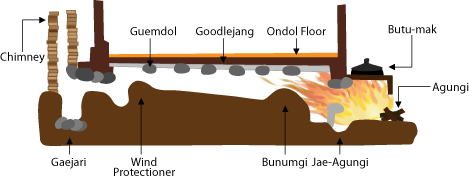Agungi on:
[Wikipedia]
[Google]
[Amazon]
An ''agungi'' () is a firebox found in traditional Korean kitchens which is used to burn
File:Goguryeo buttumak 1.jpg, Iron ''buttumak'' from
 ''Buttumaks'' in agrarian Korean kitchens were commonly made from
''Buttumaks'' in agrarian Korean kitchens were commonly made from
firewood
Firewood is any wooden material that is gathered and used for fuel. Generally, firewood is not heavily processed, and is in some sort of firelog, recognizable log or branch form, compared to other forms of wood fuel like pellet fuel, pellets. ...
or other fuel
A fuel is any material that can be made to react with other substances so that it releases energy as thermal energy or to be used for work (physics), work. The concept was originally applied solely to those materials capable of releasing chem ...
for cooking
Cooking, also known as cookery or professionally as the culinary arts, is the art, science and craft of using heat to make food more palatable, digestible, nutritious, or Food safety, safe. Cooking techniques and ingredients vary widely, from ...
. It is also a part of the traditional floor heating system, or ondol. The flat cooktop counter or hearth
A hearth () is the place in a home where a fire is or was traditionally kept for home heating and for cooking, usually constituted by a horizontal hearthstone and often enclosed to varying degrees by any combination of reredos (a low, partial ...
installed over the ''agungi'' is called a ''buttumak'' ().
History
Early ''buttumak'' have been dated to the 10th‒4th century BCE. Iron and ceramic ''buttumaks'', similar to their later forms, were excavated fromGoguryeo
Goguryeo (37 BC – 668 AD) (; ; Old Korean: Guryeo) also later known as Goryeo (; ; Middle Korean: 고ᇢ롕〮, ''kwòwlyéy''), was a Korean kingdom which was located on the northern and central parts of the Korea, Korean Peninsula an ...
1st century BCE historical sites, such as Anak Tomb No. 3.
Many Korean agrarian kitchens had ''buttumak'' with charcoal-fueled ''agungi'' until the early 1970s.
Goguryeo
Goguryeo (37 BC – 668 AD) (; ; Old Korean: Guryeo) also later known as Goryeo (; ; Middle Korean: 고ᇢ롕〮, ''kwòwlyéy''), was a Korean kingdom which was located on the northern and central parts of the Korea, Korean Peninsula an ...
(37 BCE ‒ 668 CE)
File:Agungi door 1.jpg, ''Agungi'' door from agrarian South Korea
South Korea, officially the Republic of Korea (ROK), is a country in East Asia. It constitutes the southern half of the Korea, Korean Peninsula and borders North Korea along the Korean Demilitarized Zone, with the Yellow Sea to the west and t ...
in the mid-20th century
Structure
 ''Buttumaks'' in agrarian Korean kitchens were commonly made from
''Buttumaks'' in agrarian Korean kitchens were commonly made from brick
A brick is a type of construction material used to build walls, pavements and other elements in masonry construction. Properly, the term ''brick'' denotes a unit primarily composed of clay. But is now also used informally to denote building un ...
or stone
In geology, rock (or stone) is any naturally occurring solid mass or aggregate of minerals or mineraloid matter. It is categorized by the minerals included, its Chemical compound, chemical composition, and the way in which it is formed. Rocks ...
and then smoothed with clay
Clay is a type of fine-grained natural soil material containing clay minerals (hydrous aluminium phyllosilicates, e.g. kaolinite, ). Most pure clay minerals are white or light-coloured, but natural clays show a variety of colours from impuriti ...
.
Above each ''agungi'' is an upward opening where '' gamasot'' (big pot or cauldron used on ''agungi'') can be set onto the ''buttumak''. A kitchen may have ''buttumak'' with multiple ''agungi'' holes and upward openings, or a single ''agungi'' hole and a single upward opening. Each ''agungi'' can be covered with an iron plate or door to control the fire.
''Agungi'' and ''buttumak'' are among the main components of the traditional '' ondol'' (floor heating) system. Vents in the back of ''agungi'' are opened on cold days to allow the smoke and hot air flow through the flues underneath ''ondol'' rooms and exit into the chimney at the other end of the house.
Influences
Japanese '' kamado'' was their adaptation of ''buttumak'' introduced from Korea. The word '' kamado'' () also has its root in Korean word ''gama'' (가마), asynonym
A synonym is a word, morpheme, or phrase that means precisely or nearly the same as another word, morpheme, or phrase in a given language. For example, in the English language, the words ''begin'', ''start'', ''commence'', and ''initiate'' are a ...
of ''buttumak''. The word ''gama'' in modern Korean is usually used to refer to kiln
A kiln is a thermally insulated chamber, a type of oven, that produces temperatures sufficient to complete some process, such as hardening, drying, or Chemical Changes, chemical changes. Kilns have been used for millennia to turn objects m ...
s, but the usage of the word meaning ''buttumak'' can be found in some compounds such as '' gamasot'' (literally ''gama'' cauldron) referring to the cauldron used on ''buttumak''.
See also
* Cook stove * Furnace *Hearth
A hearth () is the place in a home where a fire is or was traditionally kept for home heating and for cooking, usually constituted by a horizontal hearthstone and often enclosed to varying degrees by any combination of reredos (a low, partial ...
* Hibachi
* Hob
* Kang bed-stove
* Kiln
A kiln is a thermally insulated chamber, a type of oven, that produces temperatures sufficient to complete some process, such as hardening, drying, or Chemical Changes, chemical changes. Kilns have been used for millennia to turn objects m ...
* Masonry heater
* Russian stove
References
Fireplaces Hanok Cooking appliances Stoves {{Korea-stub